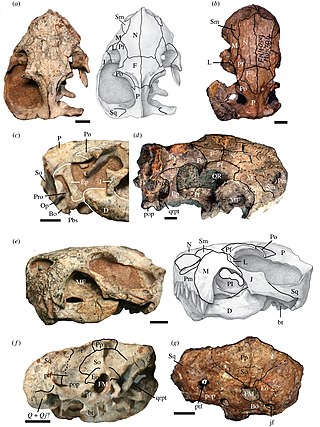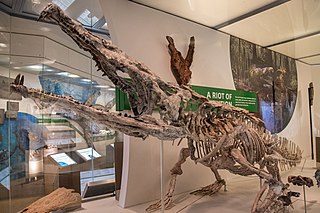
Rhynchocephalia is an order of lizard-like reptiles that includes only one living species, the tuatara of New Zealand. Despite its current lack of diversity, during the Mesozoic rhynchocephalians were a speciose group with high morphological and ecological diversity. The oldest record of the group is dated to the Middle Triassic around 238 to 240 million years ago, and they had achieved a worldwide distribution by the Early Jurassic. Most rhynchocephalians belong to the group Sphenodontia ('wedge-teeth'). Their closest living relatives are lizards and snakes in the order Squamata, with the two orders being grouped together in the superorder Lepidosauria.

Revueltosaurus is an extinct genus of suchian pseudosuchian from Late Triassic deposits of New Mexico, Arizona and North Carolina, United States. Many specimens, mostly teeth, have been assigned to Revueltosaurus over the years. Currently, three species are included in this genus, all of which were originally thought to represent monospecific genera of basal ornithischian dinosaurs. Revueltosaurus was about 1 meter long.

Camposaurus is a coelophysid dinosaur genus from the Norian stage of the Late Triassic period of North America. The pertinent fossil remains date back to the early to middle Norian stage, and is widely regarded as the oldest known neotheropod.

Crosbysaurus is a genus of extinct archosauromorph that lived in the Late Triassic of Arizona, New Mexico, North Carolina, Texas, and Utah. It is known from the Chinle Formation and Dockum Group rock units from the southwestern United States. The type species is C. harrisae, and the only known material includes teeth. 11 specimens are known, each including a single tooth.

The Chinle Formation is an Upper Triassic continental geological formation of fluvial, lacustrine, and palustrine to eolian deposits spread across the U.S. states of Nevada, Utah, northern Arizona, western New Mexico, and western Colorado. In New Mexico, it is often raised to the status of a geological group, the Chinle Group. Some authors have controversially considered the Chinle to be synonymous to the Dockum Group of eastern Colorado and New Mexico, western Texas, the Oklahoma panhandle, and southwestern Kansas. The Chinle Formation is part of the Colorado Plateau, Basin and Range, and the southern section of the Interior Plains. A probable separate depositional basin within the Chinle is found in northwestern Colorado and northeastern Utah. The southern portion of the Chinle reaches a maximum thickness of a little over 520 meters (1,710 ft). Typically, the Chinle rests unconformably on the Moenkopi Formation.

Euchambersia is an extinct genus of therocephalian therapsids that lived during the Late Permian in what is now South Africa and China. The genus contains two species. The type species E. mirabilis was named by paleontologist Robert Broom in 1931 from a skull missing the lower jaw. A second skull, belonging to a probably immature individual, was later described. In 2022, a second species, E. liuyudongi, was named by Jun Liu and Fernando Abdala from a well-preserved skull. It is a member of the family Akidnognathidae, which historically has also been referred by as the synonymous Euchambersiidae.

Trilophosaurus is a lizard-like trilophosaurid allokotosaur known from the Late Triassic of North America. It was a herbivore up to 2.5 m long. It had a short, unusually heavily built skull, equipped with massive, broad flattened cheek teeth with sharp shearing surfaces for cutting up tough plant material. Teeth are absent from the premaxilla and front of the lower jaw, which in life were probably equipped with a horny beak.

Smilosuchus is an extinct genus of leptosuchomorph parasuchid from the Late Triassic of North America.

Anaschisma is an extinct genus of large temnospondyl amphibians. These animals were part of the family called Metoposauridae, which filled the crocodile-like predatory niches in the late Triassic. It had large skull about 62 centimetres (24 in) long, and possibly reached 3 metres (9.8 ft) long. It was an ambush hunter, snapping up anything small enough to fit in its huge jaws. It was very common during the Late Triassic in what is now the American Southwest.

Leptosuchus is an extinct genus of leptosuchomorph phytosaur with a complex taxonomical history. Fossils have been found from the Dockum Group and lower Chinle Formation outcropping in Texas, New Mexico, and Arizona, USA, and date back to the Carnian stage of the Late Triassic.
Parrishia is an extinct genus of sphenosuchian crocodylomorph known from the Late Triassic Chinle, Dockum, and Santa Rosa Formations in Arizona and New Mexico.

Vancleavea is a genus of extinct, armoured, non-archosaurian archosauriforms from the Late Triassic of western North America. The type and only known species is V. campi, named by Robert Long & Phillip A Murry in 1995. At that time, the genus was only known from fragmentary bones including osteoderms and vertebrae. However, since then many more fossils have been found, including a pair of nearly complete skeletons discovered in 2002. These finds have shown that members of the genus were bizarre semiaquatic reptiles. Vancleavea individuals had short snouts with large, fang-like teeth, and long bodies with small limbs. They were completely covered with bony plates known as osteoderms, which came in several different varieties distributed around the body. Phylogenetic analyses by professional paleontologists have shown that Vancleavea was an archosauriform, part of the lineage of reptiles that would lead to archosaurs such as dinosaurs and crocodilians. Vancleavea lacks certain traits which are present in most other archosauriforms, most notably the antorbital, mandibular and supratemporal fenestrae, which are weight-saving holes in the skulls of other taxa. However, other features clearly support its archosauriform identity, including a lack of intercentra, the presence of osteoderms, an ossified laterosphenoid, and several adaptations of the femur and ankle bones. In 2016, a new genus of archosauriform, Litorosuchus, was described. This genus resembled both Vancleavea and more typical archosauriforms in different respects, allowing Litorosuchus to act as a transitional fossil linking Vancleavea to less aberrant archosauriforms.
The Chinle Formation is an extensive geological unit in the southwestern United States, preserving a very diverse fauna of Late Triassic animals and plants. This is a list of fossilized organisms recovered from the formation.
Colognathus is a genus of extinct reptile from Late Triassic rocks of the southwestern United States. It was described in 1928 from a jaw fragment by Case, who interpreted the new taxon as a fish. The type species is C. obscurus.
Variodens is an extinct genus of trilophosaur. Fossils have been found from the Emborough Quarries in the Mendip Hills of Somerset, England. These fossils have been uncovered from a Late Triassic fissure fill within Carboniferous-age limestone. The type and only known species is V. inopinatus, named in 1957.
Libognathus is an extinct genus of procolophonid parareptile from the Late Triassic of Texas. The type and only species, Libognathus sheddi, was named in 1997 from the Cooper Canyon Formation in the fossil-rich Post Quarry, which is found in Garza County. Libognathus was the first definite procolophonid discovered in the southwestern United States, although another possible procolophonid called Chinleogomphius was reported from the southwest before Libognathus was named.
The Colorado City Formation is a Late Triassic geologic formation in the Dockum Group of Texas, United States. It has previously been known as the Iatan Member, Colorado City Member or 'Pre-Tecovas Horizon'.
Palacrodon is an extinct genus of Triassic reptile with a widespread distribution. It was initially described from teeth collected in Early Triassic deposits in South Africa, and later reported from the Early Triassic of Antarctica and the Late Triassic of Arizona. Although previously considered an early rhynchocephalian, it is currently considered to be a non-saurian neodiapsid.
Kraterokheirodon is an extinct genus of enigmatic tetrapod, that was possibly an amniote, from the Late Triassic Chinle Formation of Arizona. The type and only species is K. colberti. Although it is known only from two large teeth, their shape is so unlike those of any other animal that Kraterokheirodon cannot definitively be classified under any known group of tetrapods. Its discovery also indicates that our understanding of Late Triassic tetrapod diversity is still incomplete, with Kraterokheirodon representing an otherwise unknown lineage of large tetrapod in western North America.
Syntomiprosopus is an extinct genus of archosauriform, possibly a crocodylomorph from the Late Triassic period of Arizona. The type and only known species is S. sucherorum. Syntomiprosopus was unusually short-snouted, comparable to the Late Cretaceous notosuchian Simosuchus, and is regarded as an example of convergent evolution between Triassic stem-archosaurs and Cretaceous archosaurs.













